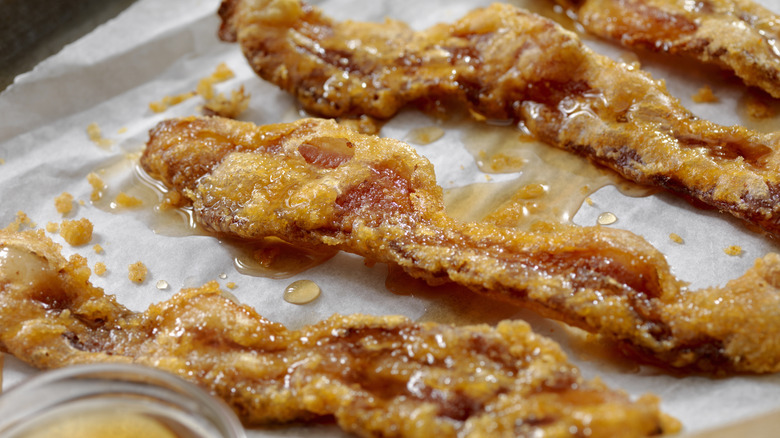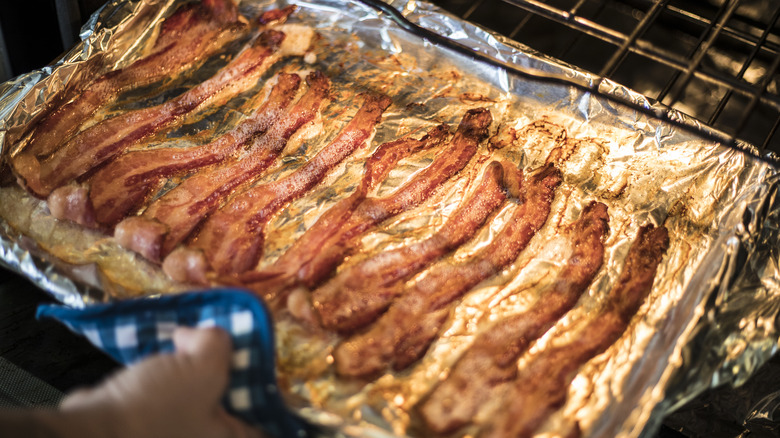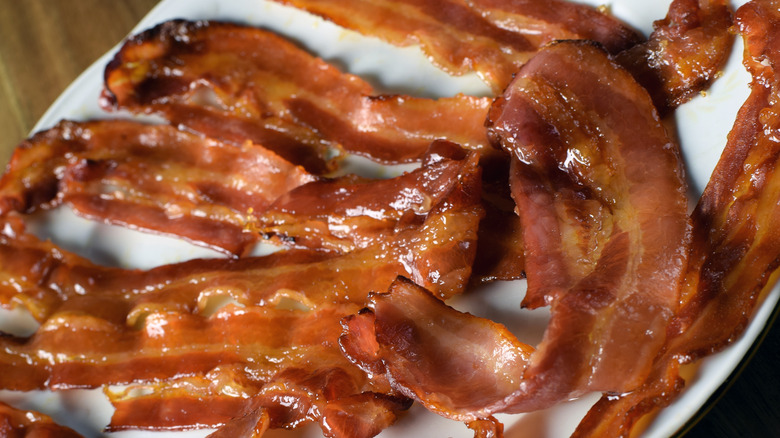How To Cook Candied Bacon Without Burning The Sugar
Sweet, savory, and salty with a delightful combination of crunch and chewiness, candied bacon makes a delicious sidekick for so many breakfast dishes, from perfect homemade pancakes to fluffy French toast. It often consists of just two ingredients — bacon and brown sugar — so in theory, it should be a breeze to make. But in practice, the sugar can easily burn, leaving you with blackened strips that are smoky in the wrong way.
Avoiding this outcome requires the right cooking method, temperature, and ingredients. There are many different ways to cook bacon, but for delicious sizzling strips of candied pork, the oven is the best method. While it is possible to cook the sugar-coated bacon in a skillet, it can quickly create a sticky mess with burn spots as the sugar melts. The more consistent heat of the oven makes it easier to get evenly-cooked bacon, so that both sides of the strips develop a caramelized texture.
The oven has other advantages, too. It makes it easy to prepare a large batch of bacon at once, which is especially useful for when making breakfast or brunch for a crowd. It also eliminates the spluttering fat you can get from the stovetop method — neither bacon fat nor bits of caramelized sugar are fun to clean up. A few more tips will help you along to perfectly candied pork.
Use the oven for evenly cooked candied bacon
Since there are only a couple of ingredients in candied bacon, it's important to choose them wisely. For the bacon, use classic-cut strips if you like a mixture of crispy and chewy meat. Thick-cut bacon also works well for a chewier texture, but it takes longer to cook, so be extra vigilant about keeping an eye on the sugary exterior to prevent burning.
You can use different kinds of sugar to coat the bacon, but light brown is most suitable. Dark brown sugar can cause faster browning since it contains more molasses, risking a burnt result. Meanwhile, white granulated sugar doesn't caramelize as deeply. A good ratio is a third of a cup of light brown sugar for each pound of bacon.
Once you've tossed the raw bacon in sugar to evenly coat it, place it on an oven-safe cooling rack over a tray lined with aluminum foil or parchment paper. The raised rack helps hot air circulate on all sides of the bacon, so no need to flip. Any fat and any excess sugary coating will drip into the lined tray below, making it easier to clean up afterwards. Bake the bacon at 350 degrees Fahrenheit, since sugar burns easily at temperatures above this. The exact cooking time will depend on the thickness of the meat, but check it at regular intervals to prevent scorching.
More ways to sweeten and season candied bacon
While light brown sugar on its own will produce delightfully crispy and caramelized candied bacon, there are several ways to take it up a notch. Adding a little freshly-ground black pepper to the sugar before coating the strips is an easy way to add a burst of heat to balance the sweet and salty flavors. Or go for chili powder or cayenne pepper if you really want to ramp up the spice.
For a delicious flavor combination as well as an enticing aroma, you can use cinnamon brown sugar in place of the plain stuff. Bacon with this coating would be especially complementary to pancakes, French toast, or waffles. Or, go for a blend of different herbs and spices such as rosemary, thyme, and paprika for a bold color and added smokiness, as well as an extra burst of fragrant flavor.
To elevate and amplify the sweetness with some complexity, try replacing part of the sugar with maple syrup or honey. You can even add an equal amount of rice vinegar along with the honey or syrup, which tone down the sweetness if you're worried it will be overpowering. However, don't be tempted to use a granulated sugar substitute, as it won't caramelize in the same way that sugar, honey, or syrup do. Whichever ingredient you use, let the strips cool a little on the rack after cooking, so the sweet glaze can set nicely.



